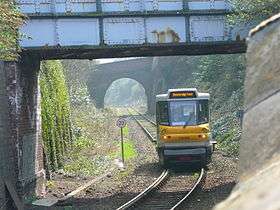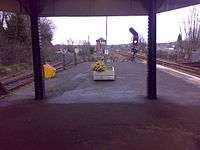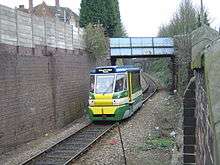Stourbridge Town branch line
The Stourbridge Town branch line is a 0.8 miles (1.3 km) railway branch line, in Stourbridge, West Midlands, England. It is claimed to be the shortest branch line in Europe, and many miniature railways are certainly longer.
| Stourbridge Town branch line | |
|---|---|
 A Parry People Mover approaching Stourbridge Town station. | |
| Overview | |
| Type | Branch line |
| Locale | West Midlands |
| Termini | Stourbridge Junction Stourbridge Town |
| Operation | |
| Owner | Network Rail |
| Operator(s) | Pre Metro Operations (on behalf of West Midlands Trains) |
| Rolling stock | 2 Class 139s |
| Technical | |
| Line length | 0.8 miles (1.3 km) |
| Number of tracks | Single track throughout |
| Track gauge | 1,435 mm (4 ft 8 1⁄2 in) standard gauge |
Now used solely for passenger traffic, it was originally constructed to allow transshipment with the Stourbridge Town Arm of the Stourbridge Canal.
The passenger service along the branch is operated by Pre Metro Operations on behalf of West Midlands Trains. It is currently branded as part of the West Midlands Railway sub-brand. Under the previous franchise, which ended on 10 December 2017, the service was branded as the London Midland Stourbridge Shuttle.
Service is provided using two Class 139 Parry People Movers. Replacement buses ran from December 2008 until March 2009 due to the previous Class 153 being reallocated from December 2008, this being the date the Parry People Mover was originally intended to start working the service. However, due to customer feedback, the Class 153 was re-introduced from 15 March until mid June, when the Parry People Mover finally entered full service. For the first time in many years, a Sunday service is operated.
History and usage
| Stourbridge Town branch line | ||||||||||||||||||||||||||||||
|---|---|---|---|---|---|---|---|---|---|---|---|---|---|---|---|---|---|---|---|---|---|---|---|---|---|---|---|---|---|---|
| ||||||||||||||||||||||||||||||

Constructed by the Great Western Railway, the short and steeply inclined branch originally carried both passenger traffic from nearby Stourbridge Junction to the terminus at Stourbridge Town and freight to the Amblecote Goods Depot at Stourbridge Basin. The branch opened for passenger traffic on 1 August 1879 and for goods traffic on 1 January 1880. It briefly closed between April 1915 and February 1919 due to the First World War,[1] but has otherwise remained open since.
Although the branch line was originally double-tracked, after 1935 the two tracks were worked as two parallel single lines, with the non-passenger track used for freight workings beyond the station over a bridge across Foster Street (a bridge rebuilt in 1957 then subsequently demolished in 1967 after the goods branch closed) towards the Stourbridge Basin. The station and branch were listed for closure under the Beeching Axe, but were later delisted in 1965.
The goods branch closed in 1965.[2] The 1879 Stourbridge Town station survived mostly intact until February 1979 when it was demolished and the branch cut back by 70 yards, leaving room for a bus station.
The line was controlled by traditional semaphore signals until at least 1990, later than the adjacent main line. However, the line is currently worked by the 'One Train Working' system with a train staff as authority to occupy the line, and there are no working signals.
Rail traffic on the line

The line has been used several times as the test route for new types of small rail transport. The Great Western Railway used both autotrains and one of the early railcars on this route, and in December 2005 the route began being used to test the Parry People Mover, a highly energy-efficient railcar, to provide the Sunday service. The experiment has been sufficiently successful to the extent that the Sunday service in June 2006 was included in both the Network Rail printed timetables and Internet site, and now runs on a permanent basis.
The line has been operated by two Class 139 Parry People Movers since June 2009. It was previously operated by a single Class 153 car, and prior to that a Class 121, locally known as Daisy the DMU.[3]
Although the line has been threatened with closure several times in the past, People Mover have suggested that should their railcar prove a success, their service could be further extended into Stourbridge town centre as a light rail system(By who?). Press reports in August 2010 marked the milestone of half a million passengers having been passed, and indicate substantial growth rates and reliability levels comparable to the Docklands Light Railway; a new depot could consolidate this early success.[4]
The train operates six times per hour over the line, with a journey time of three minutes.
Passenger volume
These are the passenger figures on the line from the year beginning April 2002 to the year beginning April 2018. Comparing the two years, Stourbridge Town has increased by 251% and Stourbridge Junction by 489%.[5]
| Station usage | ||||||||||||||||
|---|---|---|---|---|---|---|---|---|---|---|---|---|---|---|---|---|
| Station name | 2002–03 | 2004–05 | 2005–06 | 2006–07 | 2007–08 | 2008–09 | 2009–10 | 2010–11 | 2011–12 | 2012–13 | 2013–14 | 2014–15 | 2015–16 | 2016–17 | 2017–18 | 2018–19 |
| Stourbridge Town | 235,402 | 200,007 | 233,499 | 258,700 | 278,813 | 540,898 | 557,502 | 592,838 | 471,222 | 479,516 | 483,434 | 497,736 | 545,700 | 575,406 | 634,494 | 591,502 |
| Stourbridge Junction | 340,961 | 370,509 | 394,422 | 444,189 | 499,584 | 1,138,070 | 1,159,270 | 1,206,996 | 1,149,406 | 1,216,418 | 1,276,010 | 1,323,824 | 1,434,312 | 1,466,966 | 1,585,200 | 1,667,752 |
| The annual passenger usage is based on sales of tickets in stated financial years from Office of Rail Regulation statistics. The statistics are for passengers arriving and departing from each station and cover twelve month periods that start in April. Methodology may vary year on year. Barking and Blackhorse Road are affected by usage of the ticket gates for the underground and that Gospel Oak connects to the North London Line section of the London Overground and is similarly affected. Barking is further affected by the ticket gates used to access C2C services. | ||||||||||||||||
Accidents
The branch has become notorious for the steep downhill gradient leading from Junction station, and over the years there have been several incidents: [6]
- 15 June 1897 – a train of empty cattle trucks and horse boxes was being reversed down the incline when the locomotive's vacuum brake failed. The locomotive and wagons ploughed into a line of stationary wagons, the office of a local coal merchant, and stables. One man was injured.
- 24 April 1905 – the driver lost control of a locomotive descending the branch, head-first, at the head of 32 wagons. The train demolished the stop block and smashed into and through the goods office at the end of the branch. Luckily the crew managed to jump clear before impact.
- 10 February 1948 – a heavily laden freight train slipped away despite brakes being applied, with the result that wagons telescoped into each other.
- 2 April 1977 – BR Class 122 single-car diesel unit W55012 suffered a brake failure while descending the branch from Stourbridge Junction and crashed through the buffers and the wall beyond, leaving the front part of the train overhanging the road below. This unit is preserved at the Weardale Railway.
- 21 January 1989 – apparently caused by trespassers on the line distracting the driver, who consequently misjudged his braking, class 121 unit W55033 ran through the buffer stops at the end of the line and crashed through the wall beyond. The train was sent out of operation and required an overhaul.
- 1 March 1990 – in a very similar incident to the 1977 crash, brake failure caused class 121 unit W55034 to crash through the rebuilt wall at the end of the line. The buffer stop destroyed in the 1989 crash had not been replaced.
See also
- Princeton dinky - The shortest commuter rail line in America
References
- Butcher, Clive (1998). The Railways of Stourbridge. Usk: Oakwood Press. pp. 25–27. ISBN 0-85361-533-0.
- Butcher, Clive (1998). The Railways of Stourbridge. Usk: Oakwood Press. p. 115. ISBN 0-85361-533-0.
- Back Track Magazine, Volume 19, August 2005, p508 (on-line index)
- Stourbridge News: Revolutionary Tram Notches Up 500,000 Passengers
- "Station Usage". Rail Statistics. Office of Rail Regulation. Retrieved 28 February 2020.
- Butcher, Clive (1998). The Railways of Stourbridge. Usk: Oakwood Press. pp. 175–181. ISBN 0-85361-533-0.
- Christiansen, Rex. Forgotten Railways volume 10: West Midlands. David & Charles. ISBN 0-946537-01-1.
External links
| Wikimedia Commons has media related to Stourbridge Town Branch Line. |
